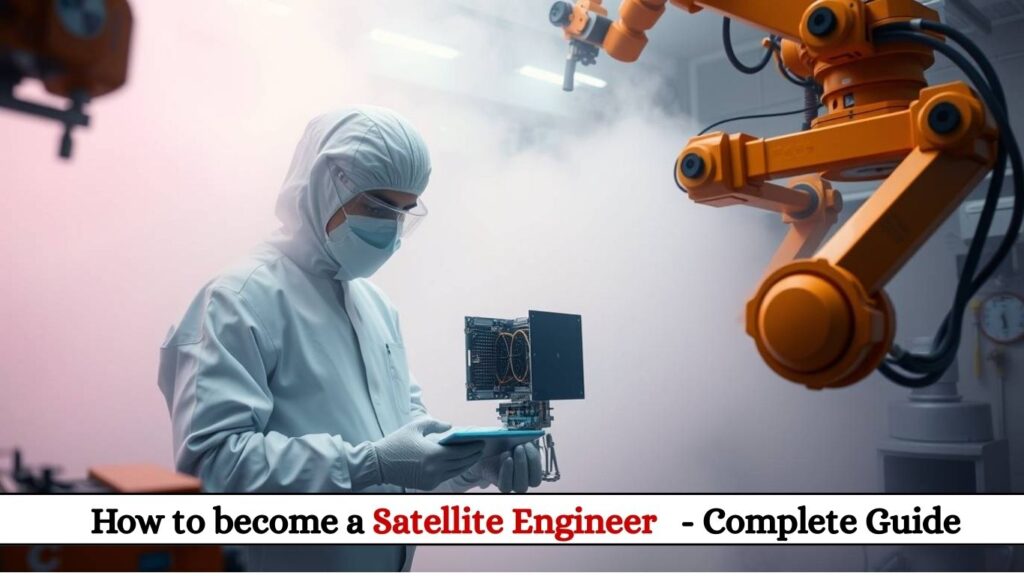
Introduction: The Rising Demand for Satellite Engineers
In our increasingly connected world, satellite engineers have become the unsung heroes of modern technology. From enabling global communications to predicting weather patterns and exploring distant planets, these specialists design, build, and maintain the spacecraft that orbit our Earth and beyond.
This comprehensive guide covers everything you need to know about this exciting career:
- History of satellite engineering
- Salary expectations across industries
- Roles & responsibilities broken down by specialization
- Qualifications needed to enter the field
- Step-by-step guide on how to get started
- Future scope and emerging technologies
- Top companies hiring satellite engineers
Whether you’re a student considering aerospace engineering or a professional looking to transition into the space sector, this guide will help you navigate your path to the stars.
History of Satellite Engineering
The Dawn of the Space Age (1950s-1960s)
- 1957: USSR launches Sputnik 1, the first artificial satellite
- 1958: NASA founded; Explorer 1 becomes America’s first satellite
- 1962: Telstar 1 enables first live transatlantic TV broadcast
Commercialization Era (1970s-1990s)
- 1970s: First geostationary communications satellites
- 1980s: GPS satellites deployed for military use
- 1990s: Iridium launches first commercial satellite phone network
Modern Revolution (2000s-Present)
- 2000s: CubeSats democratize satellite access
- 2010s: SpaceX’s Starlink begins mega-constellation deployment
- 2020s: Over 5,000 active satellites orbit Earth (and counting)
Satellite Engineer Salary Outlook (2024)
| Position | Entry-Level | Mid-Career | Senior-Level |
|---|---|---|---|
| Satellite Systems Engineer | $75,000 | $110,000 | $150,000+ |
| Payload Specialist | $85,000 | $125,000 | $170,000+ |
| Ground Station Engineer | $70,000 | $100,000 | $140,000+ |
| Satellite Operations Manager | $90,000 | $130,000 | $180,000+ |
Salary data from Glassdoor, Payscale, and Space Workforce 2030 report
Highest Paying Sectors:
- Defense & Military (Lockheed Martin, Northrop Grumman)
- Commercial Space (SpaceX, Amazon Kuiper)
- Government Agencies (NASA, ESA)
Roles & Responsibilities
1. Satellite Design Engineers
- Develop spacecraft structures and thermal systems
- Conduct stress analysis using CAD software
- Optimize designs for launch conditions
2. Communications Payload Engineers
- Design transponders and antennas
- Calculate link budgets
- Test signal integrity in vacuum chambers
3. Orbital Mechanics Specialists
- Calculate launch trajectories
- Plan station-keeping maneuvers
- Analyze collision avoidance
4. Ground Systems Engineers
- Design and maintain Earth stations
- Develop tracking algorithms
- Optimize data downlink protocols
5. Satellite Operations Controllers
- Monitor spacecraft health in real-time
- Execute orbital maneuvers
- Troubleshoot anomalies
Qualifications & Skills Required
Educational Requirements
- Bachelor’s Degree in:
- Aerospace Engineering
- Electrical/Electronics Engineering
- Physics (with space systems focus)
- Preferred Advanced Degrees:
- Master’s in Space Systems Engineering
- Ph.D. in Satellite Communications
Technical Skills
✔ CAD (SolidWorks, CATIA)
✔ MATLAB/Simulink for simulations
✔ RF and antenna theory
✔ Python for data analysis
✔ Systems engineering principles
Certifications
- INCOSE Systems Engineering Certification
- RF Engineer Certification (IEEE)
- Satellite Operations Training (e.g., ESA’s ESOC program)
How to Become a Satellite Engineer: Step-by-Step
Step 1: Build Your Educational Foundation
- Take advanced math/physics in high school
- Pursue engineering internships at aerospace firms
Step 2: Gain Practical Experience
- Join university satellite projects (e.g., CubeSat teams)
- Complete co-ops at companies like Boeing or Airbus
Step 3: Specialize Your Skills
- Take online courses in:
- Orbital Mechanics (MIT OpenCourseWare)
- RF Engineering (Coursera)
- Attend space industry conferences (IAC, SmallSat)
Step 4: Enter the Industry
- Start in entry-level roles like:
- Test Engineer
- Systems Analyst
- Operations Support
Step 5: Advance Your Career
- Obtain professional engineer (PE) license
- Pursue management roles or technical expert tracks
Future Scope of Satellite Engineering
Emerging Trends (2025-2030)
- Mega-constellations: 50,000+ satellites expected in LEO
- On-Orbit Servicing: Repair and refueling satellites in space
- AI-Driven Operations: Autonomous satellite management
Growth Areas
🚀 Quantum Communications (hack-proof satellites)
🚀 Space Debris Mitigation (active removal systems)
🚀 Lunar Satellites (NASA’s Moon communications network)
Top Companies Hiring
- SpaceX (Starlink expansion)
- Amazon (Project Kuiper)
- AST SpaceMobile (Space-based cellular)
- Planet Labs (Earth observation)
- ESA/NASA (Deep space missions)
Conclusion: Your Path to the Stars
Satellite engineering offers a dynamic career at the intersection of cutting-edge technology and space exploration. With the industry projected to grow 15% annually (Bryce Space Tech), now is the perfect time to launch your career.
Key Takeaways:
- Strong engineering fundamentals are essential
- Hands-on experience through projects/internships is invaluable
- Specialization increases earning potential
- Continuous learning is crucial in this evolving field
The satellites you help build may one day enable interplanetary internet or discover new worlds. Are you ready to be part of humanity’s next giant leap?
This guide combines industry data, career advice, and to help aspiring satellite engineers navigate this exciting field. Would you like me to expand any particular section? 🛰️













Post Comment